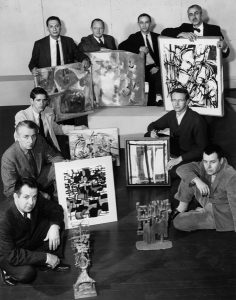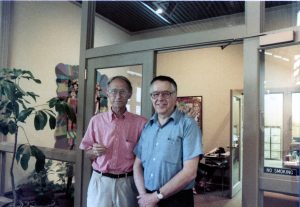“What did you do?” “Everything!”

As a teacher and mentor, Jack Granata changed the lives of many undergraduate and graduate students in art. He left a lifelong impression on four gallery assistants who worked for him during their school years at UA. We contacted alumni Rita DeWitt, Melody Machen, Kat Mitchell O’Brien and Michael Panhorst who all worked for Professor Granata in what was then known as the University Art Gallery (now the Sarah Moody Gallery of Art) in Garland Hall. When asked, each enthusiastically testified that she or he gained tangible and valuable work experiences and a deep respect for the skills and talent Mr. Granata brought to his work.
Rita DeWitt worked as the gallery’s exhibitions coordinator – a graduate student position – in 1970-71. She earned her BFA in 1970 in graphic design and her MFA in 1972 in photography and printmaking. DeWitt went on to have a long and successful career in art, both exhibiting and teaching. Her work, primarily in photography, digital photo and printmaking, has been shown in more than 200 exhibitions nationally and internationally, including over thirty solo exhibitions. It is held in many public and private collections including the Fogg Museum of Art, the San Francisco Museum of Art, the High Museum of Art in Atlanta, and the Amon Carter Museum in Fort Worth. DeWitt has taught at the University of Southern Mississippi, the School of the Art Institute of Chicago, Rhode Island School of Design, Smith College, Boston University and the University of Louisiana – Lafayette.

In an interview in 2009, DeWitt recalled that the gallery had good funding and had many traveling exhibitions from the Smithsonian, the Metropolitan, and other major national museums. “We had one major exhibition every month.” When asked what she did as his assistant, she replied, “Everything.” DeWitt was in charge of designing and hanging the exhibitions. She contracted for the exhibitions, designed promotional materials, did all correspondence and filing, did budgeting and requisitions, made wall labels, packed and unpacked shipments of works, shipped works, painted or touched up the walls before every new show, ordered food for receptions, arranged for visiting artists, and picked up and delivered artists to the airport…in short, “everything.”
In addition, DeWitt began cataloging the gallery’s Permanent Collection. “He set up the categories; I went through the flat files and cataloged everything.” She also hung shows, learned about lighting, and how to work with spots and floods. Everything was new and interesting. When a glass show came from the Smithsonian – just before the “glass renaissance,” as she put it, in the art world – she had the challenging job of installing a Dale Chihuly piece that was like a giant octopus with multiple glass tentacles.
DeWitt learned the procedures and methods of curating from Granata, but what seemed most memorable to her were the small, subtle things she learned from him, from watching him work. “He would choose a group of objects to put together. He would reach out and nudge one and [make the whole group come together]. He had a real sense of how to arrange objects in space.”

Jack Granata seemed to have a talent for finding the one element which, when changed, would change everything around it. His attention to detail was a quality that all the assistants experienced. Melody Machen (MFA 1973), now an artist and art teacher, remembers that well: “He was so patient, yet so very exacting, as he showed me how to hang an art exhibit. We had to wipe every nail before hammering it to make sure that no oxidation soiled the gallery cloth [of the walls]. He had me carefully part the fibers of the gallery cloth so that the nail wouldn’t split the threads. He told me that I didn’t know how to hold a hammer correctly (I didn’t!).”
Machen said, “I think my first show to hang was painted temple food cloths from Rajasthan. It went up pretty fast – the cloths were large and mostly symmetrical…It was a lot more difficult to hang a show of Peter Max prints. I think we spent hours just deciding where to put the small prints, many more wiping the nails and hammering.”
The quality of the exhibitions Granata chose also impressed Machen, who was an abstract painter. He brought in internationally known artists who the assistants recognized from their studies. Machen remembers: “The University Art Gallery had some great shows [such as] Robert Motherwell, Lee Krasner, and Ten Young Artists [winners of the Theodoron Awards, organized by the Guggenheim Museum in New York in 1972], including George Trakas who came to Tuscaloosa to build a mixed-media installation.” Machen also received hands-on experience cataloging the Permanent Collection: “There was no Internet to help find values for the Ansel Adams portfolios or the Lee Krasner painting [in the Permanent Collection]. [Somehow] Mr. Granata arrived at the figures. Mostly I typed, very slowly.”
Kat Mitchell O’Brien (BFA 1972, MFA 1975), now an internationally recognized sculptor, worked with Granata from 1973 to 1974. O’Brien also cataloged the Permanent Collection: “The Permanent Collection at that time was, shall we say, intimately around me every day in my ‘office’ in the back storeroom.”
O’Brien writes that now, “I rarely drive a nail into an exhibition wall without remembering his attention to details and his fingers carefully separating the threads of the Woods Hall wall fabric, again cautioning about using nails that will not split threads or leave stains…. the multi-color-coded paints on every tool purchased by the department.”
Michael Panhorst (BA 1977 New College) feels that what he learned from Granata set him on his current career path. Panhorst, now Curator of Art at the Montgomery Museum of Fine Arts, was Granata’s first undergraduate gallery assistant. He knew early that he wanted to be a curator and museum director. He worked as a student intern for Granata in the University Art Gallery in the spring of 1974, and then Granata offered him the part-time gallery assistant position. Panhorst, who earned his BA in 1977 through New College with a depth study in arts management, wrote that he “basically majored in art history and minored in business administration.”
Panhorst credits Jack Granata with giving him a boost in the work world. “My work with him definitely helped with my career and my life. In fact, the University of Delaware Museum Studies program waived my requirement for an internship because of my wealth of experience with the University Art Gallery. Mr. Granata certainly helped me understand how galleries, museums, and the larger art world work.”
The Loupe, Spring 2011